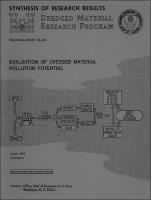Please use this identifier to cite or link to this item:
https://hdl.handle.net/11681/4660| Title: | Evaluation of dredged material pollution potential |
| Authors: | Brannon, James M. |
| Keywords: | Aquatic ecology Water--Pollution Dredging Dredging spoil Dredged material |
| Publisher: | U. S. Army Engineer Waterways Experiment Station |
| Series/Report no.: | Technical Report (Dredged Material Research Program (U.S.)) ; no. DS-78-6 |
| Abstract: | This report synthesizes data from the U. s. Army Engineer Waterways Experiment Station, Dredged Material Research Program (DMRP), Task 1E. Task 1E consisted of seven research projects (work units) that investigated the pollution properties of dredged material and procedures for determining their potential for effect on water quality and aquatic organisms. The short-term impact of dredged material on water quality and aquatic organisms is related to the concentration of chemically mobile, readily available contaminants rather than the total concentration. The Elutriate Test, which measures concentrations of contaminants released from dredged material, can be used to evaluate short-term impacts on water quality. The only constituents generally released from dredged material are manganese and ammonium -N. Elevated concentrations of these constituents, however, are of short duration because of rapid mixing and are of low frequency due to the intermittent nature of most disposal operations. The short-term chemical and biological impacts of dredging and disposal have generally been minimal. Longer term impacts of dredged material on water quality have generally been slight and can be evaluated by means of the Elutriate Test and analysis of the mobile forms of sediment contaminants. No significant long-term increase in water column contaminant concentrations has been observed at any aquatic disposal field site. The greatest hazard of dredged material disposal is the potential effect of the material on benthic organisms. Most dredged material has not proven particularly toxic. Some dredged material, however, can be extremely toxic or of unknown toxicological character. Benthic bioassay procedures are now available which can identify this toxic dredged material. |
| Description: | Technical Report |
| Gov't Doc #: | Technical Report DS-78-6 |
| Rights: | Approved for Public Release; Distribution is Unlimited |
| URI: | http://hdl.handle.net/11681/4660 |
| Appears in Collections: | Technical Report |
Files in This Item:
| File | Description | Size | Format | |
|---|---|---|---|---|
| TR-DS-78-6.pdf | 5.41 MB | Adobe PDF |  View/Open |